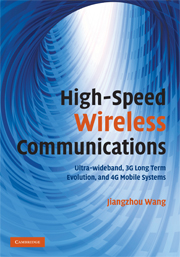Book contents
- Frontmatter
- Contents
- Preface
- Acknowledgements
- List of abbreviations
- Part I Introduction
- Part II UWB communications
- Part III Evolved 3G mobile communications
- 5 TD Receiver with ideal channel state information
- 6 TD receiver with imperfect channel estimation
- 7 QAM with antenna diversity
- 8 QAM for multicode CDMA with interference cancellation
- Part IV 4G mobile communications
- Index
- References
8 - QAM for multicode CDMA with interference cancellation
from Part III - Evolved 3G mobile communications
Published online by Cambridge University Press: 27 May 2010
- Frontmatter
- Contents
- Preface
- Acknowledgements
- List of abbreviations
- Part I Introduction
- Part II UWB communications
- Part III Evolved 3G mobile communications
- 5 TD Receiver with ideal channel state information
- 6 TD receiver with imperfect channel estimation
- 7 QAM with antenna diversity
- 8 QAM for multicode CDMA with interference cancellation
- Part IV 4G mobile communications
- Index
- References
Summary
This chapter studies MQAM for downlink multicode CDMA systems with interference cancellation to support high data rate services. In the current 3G WCDMA systems, in addition to multicode transmission, MQAM is employed for HSDPA due to its high spectral efficiency. In frequency selective fading channels, multipath interference seriously degrades the system performance. In this chapter, theoretical analysis is presented to show that with the help of interference cancellation technique, MQAM may be employed in high SNR cases to increase system throughput. Moreover, it is found that when using the interference cancellation technique, extra pilot power should be invested for more accurate channel estimation, and consequently better BER performance can be achieved.
Introduction
MQAM modulated multicode CDMA is proposed for HSDPA in the 3G standards, by which the throughput can be increased without extra bandwidth investment. As mentioned in Chapter 1, the introduction of multicode transmission causes multipath interference in frequency selective fading channels due to multipath propagation delays. In this chapter, a coherent Rake receiver with interference cancellation is studied.
Moreover, in WCDMA systems, a common pilot channel is used for channel estimation at the receiver. However, channel estimation error occurs since the received pilot channel signal suffers from the multipath interference and AWGN noise, which affects the coherent data decision and the regeneration of multipath interference, and thus degrades the system performance. The effects of imperfect channel estimation and additive multipath interference on system performance are investigated.
- Type
- Chapter
- Information
- High-Speed Wireless CommunicationsUltra-wideband, 3G Long Term Evolution, and 4G Mobile Systems, pp. 214 - 228Publisher: Cambridge University PressPrint publication year: 2008



